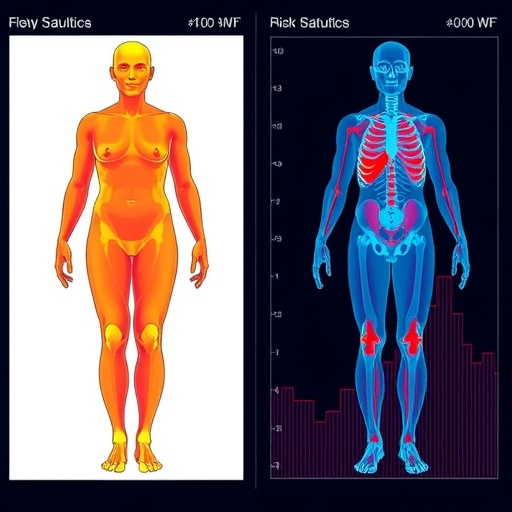Adiposity, characterized by an excessive accumulation of fat in the body, has long been recognized as a significant contributor to cardiometabolic diseases. These include prevalent conditions such as heart disease, stroke, type 2 diabetes, and kidney ailments. Understanding the various aspects of an individual’s risk for these diseases, however, is not a straightforward endeavor. Traditional metrics like body mass index (BMI) serve as broad indicators but fail to provide an accurate reflection of a person’s health status. BMI, in particular, fails to differentiate between fat and muscle mass, and does not take into account the anatomical distribution of body fat, rendering it an incomplete measure.
Researchers at Mass General Brigham, in collaboration with other specialists, sought to improve upon these traditional measurements by employing a novel AI tool specifically designed to analyze body composition in a rapid and accurate manner. The AI utilizes data from body scans to deliver comprehensive insights regarding individual health risks. Their recent findings, detailed in a study published in the prestigious journal Annals of Internal Medicine, prompt a reconsideration of how we perceive body fat and its implications for overall health. The study emphasizes that not all adipose tissue is equal, thereby reframing our understanding of adiposity’s role in the development of serious health issues.
A significant motivation behind the research is the development of an “opportunistic screening” tool. This would enable healthcare professionals to repurpose existing images from routine MRI and CT scans performed in hospitals. The goal is to identify patients who may be at elevated risk due to harmful patterns of body composition, who would otherwise go unnoticed during standard evaluations. According to Dr. Vineet K. Raghu, one of the co-senior authors, the potential of leveraging existing imaging data presents an exciting opportunity to intersect advanced technology with preventive health strategies, particularly in targeting diabetes and cardiovascular disease before they manifest into far more serious conditions.
The investigation involved an extensive prospective cohort study utilizing data derived from the U.K. Biobank. This dataset included whole-body MRI scans of over 33,000 adults who had no prior medical history of diabetes or cardiovascular incidents. The participants were monitored over a median follow-up duration of 4.2 years, during which the researchers meticulously analyzed the imagery to ascertain metrics related to body composition. The results unveiled a stark connection between AI-identified visceral adipose tissue volume—defined as fat surrounding the abdominal organs—and heightened risks of diabetes and cardiovascular conditions. This correlation persisted in both male and female subjects, reinforcing the notion that traditional metrics like BMI inadequately capture these risks.
In addition to visceral fat, the study also examined the implications of adipose deposits found within muscle tissue, revealing that such deposits further contribute to increased risks. These findings are pivotal, as they underscore the value of comprehensive body composition assessments, which significantly extend beyond what BMI and waist circumference can inform. The relationship was particularly pronounced in men, where lower skeletal muscle volumes were strongly correlated with an escalated risk of developing cardiometabolic ailments.
The implications of these findings could revolutionize preventive healthcare practices. It is increasingly clear that understanding body fat distribution and volume can offer transformative insights that are critical for preventing diseases. However, as emphasized by the team, further research is needed to validate these findings across diverse populations and verify the reliability of AI in measuring these intricate metrics from routine scans. Should future studies yield favorable results, there are far-reaching possibilities for implementing AI-driven assessments in clinical settings, leading to timely interventions for those at elevated risk.
The physics underlying these AI algorithms merit attention as well. The technology integrates sophisticated machine learning models that effectively analyze intricate data patterns emanating from body scans. The ability of AI to process massive datasets allows for nuanced assessments of anatomical structures, thereby challenging traditional paradigms inherently limited by manual measurements. As we continue to refine AI methodologies in healthcare, the potential for improved patient outcomes through early detection of risky body compositions becomes increasingly promising.
Medical professionals have long sought more reliable indicators of health, especially in populations at risk for chronic diseases. Using AI not only encompasses potential for efficiency but also offers a predictive value that could recalibrate prevention strategies. Engaging with advanced technology in this domain reflects a critical shift in medical approaches, aiming to catch existing health threats sooner than conventional methods allowed.
In conclusion, this groundbreaking study signals a paradigm shift in our comprehension of fat’s impact on health and the role of artificial intelligence in enhancing diagnostic accuracy. Following the culmination of this research into practical application could catalyze a new era in the management and prevention of cardiometabolic diseases. The journey ahead points toward a future where identifying high-risk individuals may become commonplace, ushering in a healthcare landscape that emphasizes preemptive care and individualized treatment strategies tailored to each person’s unique body composition.
The study not only spotlights the dual nature of adiposity as both a health risk and an indicator of metabolic dysfunction but also sets the stage for integrating advanced technologies into routine healthcare practices. A holistic approach to interpreting body composition signifies an opportunity for modern medicine to elevate patient care standards and future public health initiatives.
By acknowledging the intricate ties between body composition metrics and disease risk, the ongoing dialogue on cardiovascular health and diabetes prevention can be significantly advanced. As the ramifications of these findings ripple through scientific and medical communities, the discourse surrounding obesity-related conditions will undoubtedly evolve, potentially reshaping methodologies for public health interventions moving forward.
Subject of Research: People
Article Title: Association Between Body Composition and Cardiometabolic Outcomes
News Publication Date: 29-Sep-2025
Web References: DOI Link
References: Jung M et al. “Association Between Body Composition and Cardiometabolic Outcomes” Annals of Internal Medicine DOI: 10.7326/ANNALS-24-01863
Image Credits: Not provided
Keywords: Artificial intelligence, Heart disease, Type 2 diabetes, Renal failure, Cerebrovascular disorders, Magnetic resonance imaging, Adipose tissue





